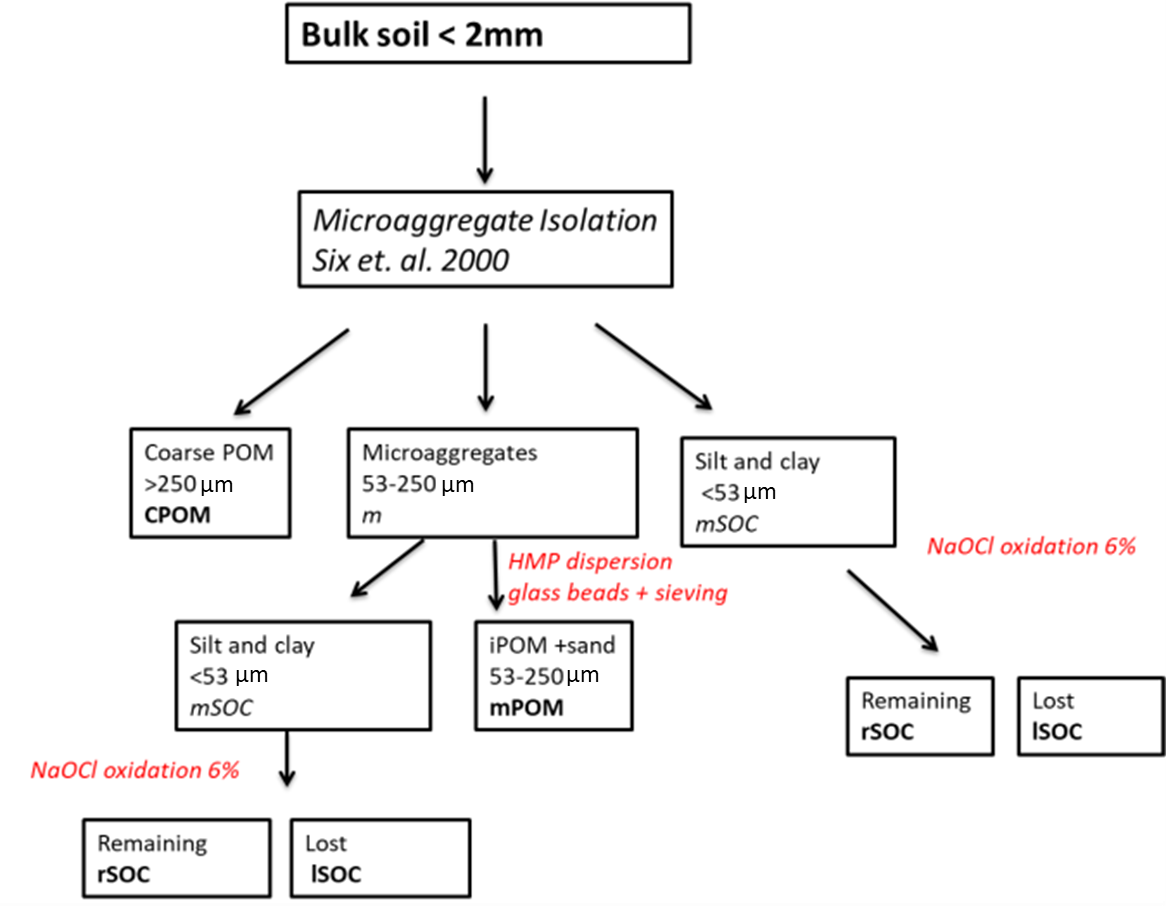Aggregates+Oxidation Six

Description and working steps
Microaggregate Isolation (Microaggregate Isolator): Bulk soil <2 mm (20 g - 30 g) is immersed in deionized water on top of a 250 µm mesh screen and gently shaken ( =150 rpm ) with 50 glass beads (diam. 4 mm). Continuous and steady water flow through the device ensures that the microaggregates are immediately flushed onto a 53-µm sieve and hence not exposed to any further disruption by the beads. The material on the 53-µm sieve is then sieved by moving the sieve 50 times up and down (approx. 3 cm). The material on the 250 µm is the CPOM fraction. In this video, microaggregate isolation is explained in detail: http://www.benchfly.com/video/189/microaggregate-isolation-protocol/.
HMP dispersion+sieving: The microaggregates (5 g) are dispersed with 10 glass beads in 5 g/L NaHMP by shaking for 18 hours on a reciprocal shaker, iPOM+sand (mPOM) versus Silt and clay (mSOC) are isolated by pouring the dispersed sample over a 53 µm sieve and rinsed thoroughly with water. NaOCl oxidation 6%, pH 8: The fractions <53 µm (mSOC) are homogenized and a subsample of 1 g is oxidized with sodium hypochlorite (NaOCl) to separate the resistant SOC fraction (rSOC). 50 ml of 6% NaOCl, adjusted to pH=8 with concentrated HCl is added to the subsample and after 18 h at 25°C the sample is centrifugated at 1000 g for 15 min and washed with deionised water. The oxidation procedure is repeated twice. The residual SOC fraction (rSOC) is dried at 40 °C.
NaOCl oxidation 6%, pH 8: The fractions <53 µm (mSOC) are homogenized and a subsample of 1 g is oxidized with sodium hypochlorite (NaOCl) to separate the resistant SOC fraction (rSOC). 50 ml of 6% NaOCl, adjusted to pH=8 with concentrated HCl is added to the subsample and after 18 h at 25°C the sample is centrifugated at 1000 g for 15 min and washed with deionised water. The oxidation procedure is repeated twice. The residual SOC fraction (rSOC) is dried at 40 °C.
Advantages
The method tries to strike a balance between isolating fractions that are 1) having a mechanistic underpinning (physical versus chemical C stabilization), 2) can be used in modeling, 3) minimize the work load.
Disadvantages
Learning to accurately do the microaggregate isolation does require some training and familiarization with the method.
References
Six, J., Elliott, E., Paustian, K., 2000. Soil macroaggregate turnover and microaggregate formation: a mechanism for C sequestration under no-tillage agriculture. Soil Biology and Biochemistry 32, 2099-2103.
Six, J., Callewaert, P., Lenders, S., De Gryze, S., Morris, S.J., Gregorich, E.G., Paul, E.A., Paustian, K., 2002. Measuring and Understanding Carbon Storage in Afforested Soils by Physical Fractionation. Soil Sci Soc Am J 66, 1981-1987.